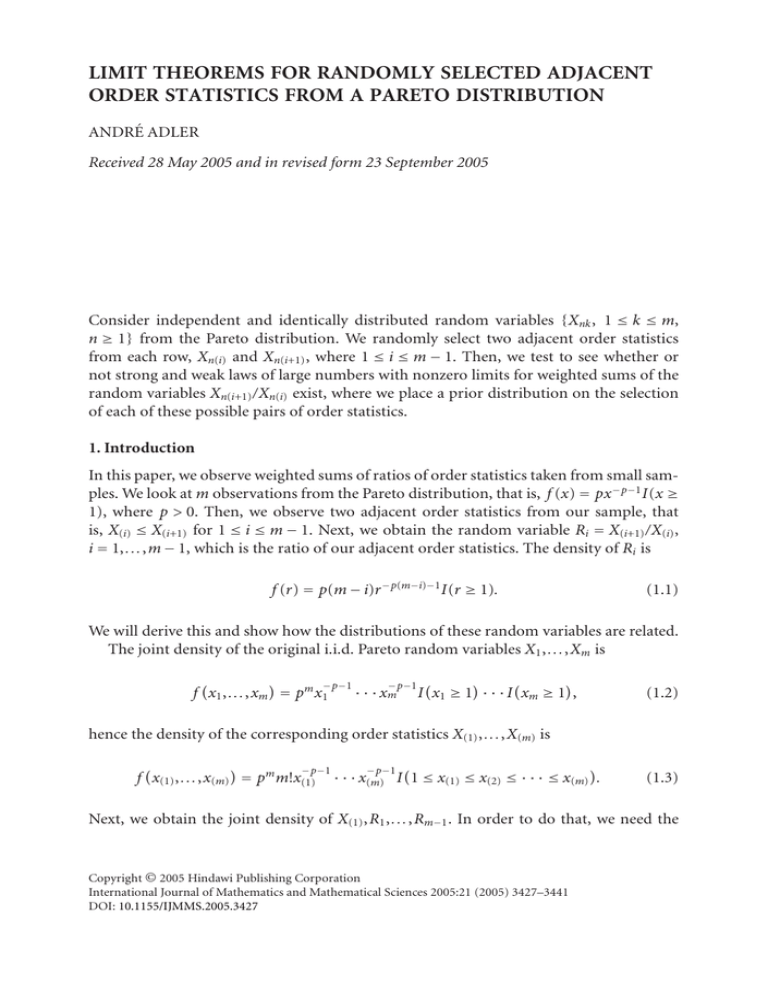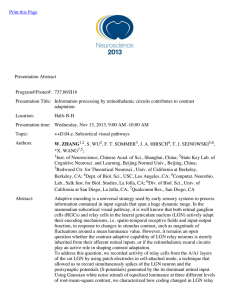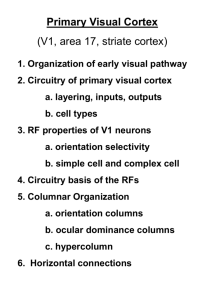LIMIT THEOREMS FOR RANDOMLY SELECTED ADJACENT
advertisement

LIMIT THEOREMS FOR RANDOMLY SELECTED ADJACENT
ORDER STATISTICS FROM A PARETO DISTRIBUTION
ANDRÉ ADLER
Received 28 May 2005 and in revised form 23 September 2005
Consider independent and identically distributed random variables {Xnk , 1 ≤ k ≤ m,
n ≥ 1} from the Pareto distribution. We randomly select two adjacent order statistics
from each row, Xn(i) and Xn(i+1) , where 1 ≤ i ≤ m − 1. Then, we test to see whether or
not strong and weak laws of large numbers with nonzero limits for weighted sums of the
random variables Xn(i+1) /Xn(i) exist, where we place a prior distribution on the selection
of each of these possible pairs of order statistics.
1. Introduction
In this paper, we observe weighted sums of ratios of order statistics taken from small samples. We look at m observations from the Pareto distribution, that is, f (x) = px− p−1 I(x ≥
1), where p > 0. Then, we observe two adjacent order statistics from our sample, that
is, X(i) ≤ X(i+1) for 1 ≤ i ≤ m − 1. Next, we obtain the random variable Ri = X(i+1) /X(i) ,
i = 1,...,m − 1, which is the ratio of our adjacent order statistics. The density of Ri is
f (r) = p(m − i)r − p(m−i)−1 I(r ≥ 1).
(1.1)
We will derive this and show how the distributions of these random variables are related.
The joint density of the original i.i.d. Pareto random variables X1 ,...,Xm is
− p −1
f x1 ,...,xm = pm x1
− p −1
· · · xm
I x1 ≥ 1 · · · I xm ≥ 1 ,
(1.2)
hence the density of the corresponding order statistics X(1) ,...,X(m) is
− p −1
f x(1) ,...,x(m) = pm m!x(1)
− p −1 · · · x(m) I 1 ≤ x(1) ≤ x(2) ≤ · · · ≤ x(m) .
(1.3)
Next, we obtain the joint density of X(1) ,R1 ,...,Rm−1 . In order to do that, we need the
Copyright © 2005 Hindawi Publishing Corporation
International Journal of Mathematics and Mathematical Sciences 2005:21 (2005) 3427–3441
DOI: 10.1155/IJMMS.2005.3427
3428
Exact laws of large numbers
inverse transformation, which is
X(1) = X(1) ,
X(2) = X(1) R1 ,
(1.4)
X(3) = X(1) R1 R2 ,
through
X(m) = X(1) R1 R2 · · · Rm−1 .
(1.5)
So, in order to obtain this density, we need the Jacobian, which is the determinant of the
matrix
∂x(1)
∂x(1)
∂x
(2)
∂x(1)
∂x(3)
∂x
(1)
.
..
∂x(1)
∂r1
∂x(2)
∂r1
∂x(3)
∂r1
..
.
∂x(1)
∂r2
∂x(2)
∂r2
∂x(3)
∂r2
..
.
∂x(1)
∂x(m)
∂r1
∂x(m)
∂r2
∂x(m)
∂x(1)
∂rm−1
∂x(2)
∂rm−1
∂x(3)
,
∂rm−1
..
.
···
···
···
..
.
∂x(m)
∂rm−1
···
(1.6)
which is the lower triangular matrix
···
···
···
1
r1
r1 r2
..
.
0
x(1)
x(1) r2
..
.
0
0
x(1) r1
..
.
r1 · · · rm−1
x(1) r2 · · · rm−1
x(1) r1 r3 · · · rm−1
..
.
0
0
0
..
.
···
x(1) r1 · · · rm−2
.
(1.7)
m−1 m−2 m−3 m−4
r1 r2 r3 · · · rm−2 .
Thus the Jacobian is x(1)
So, the joint density of X(1) ,R1 ,... ,Rm−1 is
− p −1 f x(1) ,r1 ,...,rm−1 = pm m!x(1)
x(1) r1
− p−1 x(1) r1 r2
− p−1
− p −1
· · · x(1) r1 · · · rm−1
m−1 m−2 m−3
· x(1)
r1 r2 · · · rm−2
· I 1 ≤ x(1) ≤ x(1) r1 ≤ x(1) r1 r2 ≤ · · · ≤ x(1) r1 · · · rm−1
− pm−1 − p(m−1)−1 − p(m−2)−1
−2p−1 − p−1
r1
r2
· · · rm−2 rm−1
= pm m!x(1)
· I x(1) ≥ 1 I r1 ≥ 1 I r2 ≥ 1 · · · I rm−1 ≥ 1 .
(1.8)
André Adler 3429
This shows that the random variables X(1) ,R1 ,...,Rm−1 are independent and that the density of our smallest order statistic is
− pm−1
fX(1) x(1) = pmx(1)
I x(1) ≥ 1 ,
(1.9)
while the density of the ratio of the ith adjacent order statistic Ri , i = 1,...,m − 1 is
fRi (r) = p(m − i)r − p(m−i)−1 I(r ≥ 1).
(1.10)
We repeat this procedure n times, assuming independence between sets of data, obtaining the sequence {Rn = Rni , n ≥ 1}. Notice that we have dropped the subscript i, but
the density of Rni does depend on i. Hence, we first start out with n independent sets of
m i.i.d. Pareto random variables. We then order these m Pareto random variables within
each set. Next, we obtain the m − 1 ratios of the adjacent order statistics. Finally, we select
one of these as our random variable Y . Repeating this n times, we obtain the sequence
{Yn , n ≥ 1}. We do that via our preset prior distribution {Π1 ,...,Πm−1 }, where Πi ≥ 0
−1
and m
i=1 Πi = 1. The random variable Yn is one of the Rni , i = 1,...,m − 1, chosen via this
prior distribution. In other words, P {Yn = Rni } = Πi for i = 1,2,...,m − 1. It is very important to identify which is our largest acceptable pair of order statistics since the largest
order statistic does dominate the partial sums. Hence, we define ν = max{k : Πk > 0}. We
need to do this in case Πm−1 = 0.
Our goal is to determine whether or not there exist positive constants an and bN
such that Nn=1 an Yn /bN converges to a nonzero constant in some sense, where {Yn , n ≥
1} are i.i.d. copies of Y . Another important observation is that when p(m − ν) = 1,
we have EY = ∞. These are called exact laws of large numbers since they create a fair
game situation, where the an Yn represents the amount a player wins on the nth play of
some game and bN − bN −1 represents the corresponding fair entrance fee for the participant.
In Adler [1], just one order statistic from the Pareto was observed, while in Adler [2],
ratios of order statistics were examined. Here we look at the case of randomly selecting
one of these adjacent ratios. As usual, we define lg x = log (max{e,x}) and lg2 x = lg(lgx).
We use throughout the paper the constant C as a generic real number that is not necessarily the same in each appearance.
2. Exact strong laws when p(m − ν) = 1
In this situation, we can get an exact strong law, but only if we select our coefficients and
norming sequences properly. We use as our weights an = (lgn)β−2 /n, but we could set
an = S(n)/n, where S(·) is any slowly varying function. Note that if we do change an , then
we must also revise bn , and consequently cn = bn /an .
3430
Exact laws of large numbers
Theorem 2.1. If p(m − ν) = 1, then for all β > 0,
N lim
N →∞
n =1
(lg n)β−2 /n Yn Πν
=
(lg N)β
β
almost surely.
(2.1)
Proof. Let an = (lgn)β−2 /n, bn = (lg n)β , and cn = bn /an = n(lgn)2 . We use the usual partition
N
N
1 1 an Yn =
an Yn I 1 ≤ Yn ≤ cn − EYn I 1 ≤ Yn ≤ cn
bN n=1
bN n=1
N
N
1 1 +
an Yn I Yn > cn +
an EYn I 1 ≤ Yn ≤ cn .
bN n=1
bN n=1
(2.2)
The first term vanishes almost surely by the Khintchine-Kolmogorov convergence theorem, see [3, page 113], and Kronecker’s lemma since
∞
1
EYn2 I 1 ≤ Yn ≤ cn =
2
c
n =1 n
=
m
−1
Πi
i=1
ν
Πi
i =1
=
ν
Πi
=
Πi
i =1
≤C
≤C
≤C
=C
c2
n =1 n
ER2n I 1 ≤ Rn ≤ cn
∞
1 cn
c2
n =1 n
1
cn2
1
∞
p(m − i) cn
cn2
n =1
ν ∞
1 cn
c2
i=1 n=1 n
∞
1 cn
c2
n =1 n
1
1
1
dr
dr
∞
1
c
n =1 n
∞
p(m − i)r − p(m−i)+1 dr
∞
p(m − i) cn
n =1
i =1
ν
∞
1
1
< ∞.
2
n(lgn)
n =1
r − p(m−ν)− p(ν−i)+1 dr
r − p(ν−i) dr
(2.3)
André Adler 3431
The second term vanishes, with probability one, by the Borel-Cantelli lemma since
∞
P Yn > cn =
n =1
m
−1
Πi
=
Πi
i =1
≤C
=C
≤C
≤C
=C
P Rn > cn
n =1
i=1
ν
∞
∞ ∞
n=1 cn
ν ∞ ∞
i=1 n=1 cn
ν ∞ ∞
i=1 n=1 cn
ν ∞ ∞
i=1 n=1 cn
∞ ∞
n=1 cn
∞
1
c
n =1 n
p(m − i)r − p(m−i)−1 dr
r − p(m−ν)− p(ν−i)−1 dr
r − p(ν−i)−2 dr
(2.4)
r −2 dr
r −2 dr
< ∞.
The limit of our normalized partial sums is realized via the third term in our partition
EYn I 1 ≤ Yn ≤ cn =
ν
Πi ERn I 1 ≤ Rn ≤ cn
i=1
=
ν
Πi
i=1
=
=
ν
Πi
1
cn
i=1
1
ν
cn
Πi
i=1
=
cn
ν
−1
i=1
Πi
1
cn
1
p(m − i)r − p(m−i) dr
p(m − i)r − p(m−ν)− p(ν−i) dr
(2.5)
p(m − i)r − p(ν−i)−1 dr
p(m − i)r − p(ν−i)−1 dr + Πν
cn
1
p(m − ν)r −1 dr
∼ Πν p(m − ν)lg cn ∼ Πν lgn
since
ν
−1
i=1
Πi
cn
1
p(m − i)r − p(ν−i)−1 dr ≤ C
ν
−1 cn
i =1 1
r − p−1 dr ≤ C
cn
1
r − p−1 dr = O(1).
(2.6)
3432
Exact laws of large numbers
Thus
N
n=1 an EYn I
1 ≤ Yn ≤ cn
∼
bN
Πν
N
n=1 (lgn)
(lgN)β
β−1 /n
−→
Πν
,
β
(2.7)
which completes the proof.
3. Exact weak laws when p(m − ν) = 1
We investigate the behavior of our random variables {Yn , n ≥ 1}, where we slightly increase the coefficient of Yn . Instead of an being a power of logarithm times n−1 , we now
allow an to be n to any power larger than negative one. In this case, there is no way to
obtain an exact strong law (see Section 4), but we are able to obtain exact weak laws.
Theorem 3.1. If p(m − ν) = 1 and α > −1, then
N
α
n=1 n L(n)Yn
α+1
N L(N)lgN
Πν
α+1
P
−−→
(3.1)
for any slowly varying function L(·).
Proof. This proof is a consequence of the degenerate convergence theorem, see [3, page
356]. Here, we set an = nα L(n) and bN = N α+1 L(N)lgN. Thus, for all > 0, we have
N
P Yn ≥
n =1
bN
an
=
ν
Πi
ν
P Rn ≥
n =1
i=1
=
N
Πi p(m − i)
i=1
=p
ν
Πi (m − i)
i=1
=p
ν
Πi (m − i)
i=1
<
ν N ∞
i=1 n=1 bN /an
<C
<
an
n=1 bN /an
N ∞
n=1 bN /an
N ∞
n=1 bN /an
r −2 dr
bN
N
nα L(n)
N α+1 L(N)lgN
n =1
C
−→ 0.
lg N
N ∞
N
an
n =1
=C
bN
r − p(m−i)−1 dr
r − p(m−ν)− p(ν−i)−1 dr
r − p(ν−i)−2 dr
(3.2)
André Adler 3433
Similarly,
N
Var
n =1
an
b
Yn I 1 ≤ Yn ≤ N
bN
an
=
ν
Πi
Var
n =1
i=1
<C
N
ν N
a2n bN /an
bN2
i =1 n =1
1
ν N
a2n bN /an
=C
bN2
i=1 n=1
1
N
ν a2n bN /an
=C
<C
an
b
Rn I 1 ≤ Rn ≤ N
bN
an
b2
i=1 n=1 N
1
N
a2n bN /an
n =1
bN2
1
r − p(m−i)+1 dr
r − p(m−ν)− p(ν−i)+1 dr
(3.3)
r − p(ν−i) dr
dr < C
N
an
n =1
bN
N
nα L(n)
C
≤
−→ 0.
α+1 L(N)lgN
N
lg
N
n =1
=C
As for our truncated expectation, we have
EYn I 1 ≤ Yn ≤
bN
an
=
ν
Πi ERn I 1 ≤ Rn ≤
i =1
=
ν
Πi p(m − i)
bN /an
1
i =1
=p
ν
Πi (m − i)
=p
ν
Πi (m − i)
1
bN /an
i=1
=p
ν
−1
Πi (m − i)
i=1
1
bN /an
1
r − p(m−i) dr
bN /an
i=1
bN
an
r − p(m−ν)− p(ν−i) dr
(3.4)
r − p(ν−i)−1 dr
r − p(ν−i)−1 dr + Πν
bN /an
1
r −1 dr.
The last term is the dominant term since
N
an
n =1
bN
p
ν
−1
i=1
Πi (m − i)
bN /an
1
r − p(ν−i)−1 dr < C
N
an bN /an
n =1
bN
1
r − p−1 dr < C
N
an
n =1
bN
−→ 0,
(3.5)
3434
Exact laws of large numbers
while
N
an
n =1
bN
Πν
bN /an
1
r −1 dr
N
an
b
= Πν
lg N
b
an
N
n =1
=
=
Πν
N
n =1
nα L(n)lg
N α+1 L(N)lgN/
nα L(n)
(3.6)
N α+1 L(N)lg N
Πν
N
n =1 n
α L(n)
(α + 1)lgN + lgL(N) + lg2 N − αlg n − lgL(n)
.
N α+1 L(N)lgN
The important terms are
N
α
n=1 n L(n)(α + 1)lgN
α+1
N L(N)lgN
N
(α + 1) Nn=1 nα L(n)
−→ 1,
N α+1 L(N)
=
α
α Nn=1 nα L(n)lgn
α
n=1 n L(n)(−αlgn)
=
−
−→ −
,
α+1
α+1
N L(N)lgN
N L(N)lg N
α+1
(3.7)
while the other three terms vanish as N → ∞. For completeness, we will verify these
claims:
N
α
n=1 n L(n)lgL(N)
N α+1 L(N)lgN
<
C lg L(N)
−→ 0,
lgN
<
C lg2 N
−→ 0,
lg N
N
α
n=1 n L(n)lg2 N
N α+1 L(N)lgN
N
α
n=1 n L(n)lgL(n)
N α+1 L(N)lgN
<
(3.8)
CN α+1 L(N)lgL(N) C lgL(N)
=
−→ 0.
N α+1 L(N)lgN
lg N
Therefore,
N
n=1 an EYn I
1 ≤ Yn ≤ bN /an
α
Πν
−→ Πν 1 −
,
=
bN
α+1
α+1
which completes this proof.
(3.9)
4. Further almost sure behavior when p(m − ν) = 1
Using our exact weak law, we are able to obtain a generalized law of the iterated logarithm.
This shows that under the hypotheses of Theorem 4.1, exact strong laws do not exist
when an = nα L(n), α > −1, where L(·) is a slowly varying function. Hence, the coefficients
selected in Theorem 2.1 are the only permissible ones that will allow us to obtain an exact
strong law, that is, an = S(n)/n for some slowly varying function S(·), where we used
logarithms as our function S(·).
André Adler 3435
Theorem 4.1. If p(m − ν) = 1 and α > −1, then
N
liminf
N →∞
α
n=1 n L(n)Yn
α+1
N L(N)lgN
=
Πν
α+1
almost surely,
(4.1)
N
α
=1 n L(n)Yn
limsup nα+1
= ∞ almost surely,
L(N)lgN
N →∞ N
for any slowly varying function L(·).
Proof. From Theorem 3.1, we have
N
liminf
N →∞
α
n=1 n L(n)Yn
α+1
N L(N)lgN
≤
Πν
α+1
almost surely.
(4.2)
Set an = nα L(n), bn = nα+1 L(n)lgn, and cn = bn /an = nlg n. In order to obtain the opposite inequality, we use the following partition:
N
N
1 1 an Yn ≥
an Yn I 1 ≤ Yn ≤ n
bN n=1
bN n=1
=
N
1 an Yn I 1 ≤ Yn ≤ n − EYn I 1 ≤ Yn ≤ n
bN n=1
+
(4.3)
N
1 an EYn I 1 ≤ Yn ≤ n .
bN n=1
The first term goes to zero, almost surely, since bn is essentially increasing and
∞
n =1
cn−2 EYn2 I 1 ≤ Yn ≤ n ≤
ν ∞
i=1 n=1
≤C
ν ∞
i=1 n=1
≤C
ν ∞
i=1 n=1
≤C
≤C
cn−2 ER2n I 1 ≤ Rn ≤ n
−2
cn
−2
cn
n
1
r − p(ν−i) dr
n
1
dr
ν ∞
n
c2
i=1 n=1 n
∞
1
< ∞.
2
n(lgn)
n =1
(4.4)
3436
Exact laws of large numbers
As for the second term, we once again focus on the last term, our two largest permissible order statistics,
EYn I 1 ≤ Yn ≤ n =
ν
Πi EYn I 1 ≤ Yn ≤ n
i=1
=
ν
Πi
n
i=1
=p
=p
ν
1
p(m − i)r − p(m−i) dr
Πi (m − i)
n
i =1
1
ν
n
Πi (m − i)
ν
−1
Πi (m − i)
(4.5)
r − p(ν−i)−1 dr
1
i =1
=p
r − p(m−ν)− p(ν−i) dr
n
i =1
1
r − p(ν−i)−1 dr + Πν p(m − ν)
n
1
r −1 dr
∼ Πν lg n
since
p
ν
−1
Πi (m − i)
i=1
n
1
r − p(ν−i)−1 dr < C
ν
−1 n
i =1 1
r − p−1 dr < C
n
1
r − p−1 dr = O(1).
(4.6)
Thus,
N
N
liminf
N →∞
n=1 an Yn
bN
≥ liminf
n=1 an EYn I
1 ≤ Yn ≤ n
bN
N →∞
N
Πν n=1 nα L(n)lgn
N →∞
N α+1 L(N)lgN
= lim
=
Πν
,
α+1
establishing our almost sure lower limit.
As for the upper limit, let M > 0, then
∞
P Yn > Mcn =
n =1
=
≥
ν
Πi
∞
P Rn > Mcn
i=1
n =1
ν
∞
i=1
ν
i=ν
= Πν
Πi
p(m − i)
n =1
Πi
∞
p(m − i)
n =1
∞
n =1
p(m − ν)
∞
Mcn
∞
∞
Mcn
Mcn
r − p(m−i)−1 dr
r − p(m−i)−1 dr
r − p(m−ν)−1 dr
(4.7)
André Adler 3437
= Πν
∞ ∞
n=1 Mcn
r −2 dr
∞
=
Πν 1
M n=1 cn
=
Πν 1
M n=1 nlgn
∞
= ∞.
(4.8)
This implies that
limsup
n→∞
an Yn
= ∞ almost surely,
bn
(4.9)
which in turn allows us to conclude that
N
n=1 an Yn
limsup
bN
N →∞
=∞
almost surely,
(4.10)
which completes this proof.
5. Typical strong laws when p(m − ν) > 1
When p(m − ν) > 1, we have EY < ∞, hence all kinds of strong laws exist. In this case,
{an , n ≥ 1} and {bn , n ≥ 1} can be any pair of positive sequences as long as bn ↑ ∞,
N
n=1 an /bN → L, where L = 0, and the condition involving cn = bn /an in each theorem is
satisfied. If L = 0, then these limit theorems still hold, however the limit is zero, which is
not that interesting.
This section is broken down into three cases, each has different conditions as to
whether the strong law exists. The calculation of EY follows in the ensuing lemma.
Lemma 5.1. If p(m − ν) > 1, then
EY =
ν
pΠi (m − i)
.
p(m
− i) − 1
i=1
(5.1)
Proof. The proof is rather trivial, since p(m − ν) > 1, we have
EY =
ν
i=1
Πi ERn =
ν
pΠi (m − i)
i =1
which completes the proof of the lemma.
∞
1
r − p(m−i) dr =
ν
pΠi (m − i)
,
p(m
− i) − 1
i=1
(5.2)
3438
Exact laws of large numbers
In all three ensuing theorems, we use the partition
N
N
1 1 an Yn =
an Yn I 1 ≤ Yn ≤ cn − EYn I 1 ≤ Yn ≤ cn
bN n=1
bN n=1
+
N
1 an Yn I Yn > cn
bN n=1
+
N
1 an EYn I 1 ≤ Yn ≤ cn ,
bN n=1
(5.3)
where the selection of an , bn , and cn = bn /an must satisfy the assumption of each theorem. These three hypotheses are slightly different and are dependent on how large a first
moment the random variable Y possesses. The difference in the these theorems is the
condition involving the sequence {cn , n ≥ 1}.
Theorem 5.2. If 1 < p(m − ν) < 2 and
N
lim
n=1 an Yn
bN
N →∞
=L
∞
− p(m−ν)
n=1 cn
< ∞, then
ν
pΠi (m − i)
p(m − i) − 1
i=1
almost surely.
(5.4)
Proof. The first term in our partition goes to zero, with probability one, since
∞
1
EYn2 I 1 ≤ Yn ≤ cn =
2
c
n =1 n
ν
∞
1
Πi
c2
n =1 n
i=1
≤C
≤C
≤C
ν ∞
1 cn
c2
i=1 n=1 n
∞
1 cn
c2
n =1 n
1
1
r − p(m−i)+1 dr
r − p(m−ν)+1 dr
(5.5)
∞ − p(m−ν)+2
cn
cn2
n =1
=C
ER2n I 1 ≤ Rn ≤ cn
∞
− p(m−ν)
cn
< ∞.
n =1
As for the second term,
∞
P Yn > cn =
n =1
ν
Πi
i=1
≤C
≤C
≤C
∞
P Rn > cn
n =1
ν ∞ ∞
i=1 n=1 cn
∞ ∞
n=1 cn
∞
n =1
r
r − p(m−i)−1 dr
− p(m−ν)
cn
(5.6)
− p(m−ν)−1
< ∞.
dr
André Adler 3439
Then, from our lemma and
N
N
n =1 a n
n=1 an EYn I
∼ LbN , we have
1 ≤ Yn ≤ cn
bN
ν
pΠi (m − i)
,
p(m
− i) − 1
i=1
−→ L
(5.7)
which completes this proof.
Theorem 5.3. If p(m − ν) = 2 and
∞
N
lim
n=1 an Yn
bN
N →∞
< ∞, then
2
n=1 lg(cn )/cn
=L
ν
pΠi (m − i)
p(m − i) − 1
i=1
almost surely.
(5.8)
Proof. The first term goes to zero, almost surely, since
∞
1
EYn2 I 1 ≤ Yn ≤ cn ≤
2
c
n =1 n
ν ∞
1
c2
i=1 n=1 n
≤C
≤C
≤C
=C
ER2n I 1 ≤ Rn ≤ cn
ν ∞
1 cn
c2
i=1 n=1 n
ν ∞
1
2
c
i=1 n=1 n
1
cn
∞
1 cn
c2
n =1 n
1
∞
lgcn
cn2
n =1
1
r − p(m−i)+1 dr
r − p(m−ν)+1 dr
(5.9)
r −1 dr
< ∞.
Likewise, the second term disappears, with probability one, since
∞
P Yn > cn ≤
n =1
ν ∞
P Rn > cn
i=1 n=1
ν ∞ ∞
≤C
≤C
=C
≤C
≤C
i=1 n=1 cn
∞ ∞
n=1 cn
∞ ∞
n=1 cn
r − p(m−i)−1 dr
r − p(m−ν)−1 dr
(5.10)
−3
r dr
∞
1
c2
n =1 n
∞
lg cn
n =1
cn2
< ∞.
3440
Exact laws of large numbers
As in the last proof, the calculation for the truncated mean is exactly the same, which
leads us to the same limit.
Theorem 5.4. If p(m − ν) > 2 and
∞
N
lim
n=1 an Yn
bN
N →∞
−2
n=1 cn
=L
< ∞, then
ν
pΠi (m − i)
p(m − i) − 1
i=1
almost surely.
(5.11)
Proof. The first term goes to zero, with probability one, since
∞
1
EYn2 I 1 ≤ Yn ≤ cn ≤
2
c
n =1 n
ν ∞
1
c2
i=1 n=1 n
≤C
≤C
≤C
≤C
ER2n I 1 ≤ Rn ≤ cn
ν ∞
1 cn
c2
i=1 n=1 n
1
ν ∞
1 cn
c2
i=1 n=1 n
∞
1 cn
c2
n =1 n
∞
1
c2
n =1 n
1
1
r − p(m−i)+1 dr
r − p(m−ν)+1 dr
(5.12)
r − p(m−ν)+1 dr
< ∞.
As for the second term,
∞
P Yn > cn =
n =1
ν
i=1
≤C
≤C
≤C
≤C
≤C
Πi
∞
P Rn > cn
n =1
ν ∞ ∞
i=1 n=1 cn
ν ∞ ∞
i=1 n=1 cn
∞ ∞
n=1 cn
∞ ∞
n=1 cn
∞
1
c2
n =1 n
r − p(m−i)−1 dr
r − p(m−ν)−1 dr
r − p(m−ν)−1 dr
r −3 dr
< ∞.
(5.13)
André Adler 3441
Then as in the last two theorems,
N
n=1 an EYn I
1 ≤ Yn ≤ cn
bN
which completes this proof.
−→ L
ν
pΠi (m − i)
,
p(m
− i) − 1
i=1
(5.14)
Clearly, in all of these three theorems, the situation of an = 1 and bn = n = cn is easily
satisfied. Whenever p(m − ν) > 1, we have tremendous freedom in selecting our constants. That is certainly not true when p(m − ν) = 1.
References
[1]
[2]
[3]
A. Adler, Exact laws for sums of order statistics from the Pareto distribution, Bull. Inst. Math.
Acad. Sinica 31 (2003), no. 3, 181–193.
, Exact laws for sums of ratios of order statistics from the Pareto distribution, to appear in
Central European Journal of Mathematics.
Y. S. Chow and H. Teicher, Probability Theory. Independence, Interchangeability, Martingales,
3rd ed., Springer Texts in Statistics, Springer, New York, 1997.
André Adler: Department Applied of Mathematics, College of Science and Letters, Illinois Institute
of Technology, Chicago, IL 60616, USA
E-mail address: adler@iit.edu






